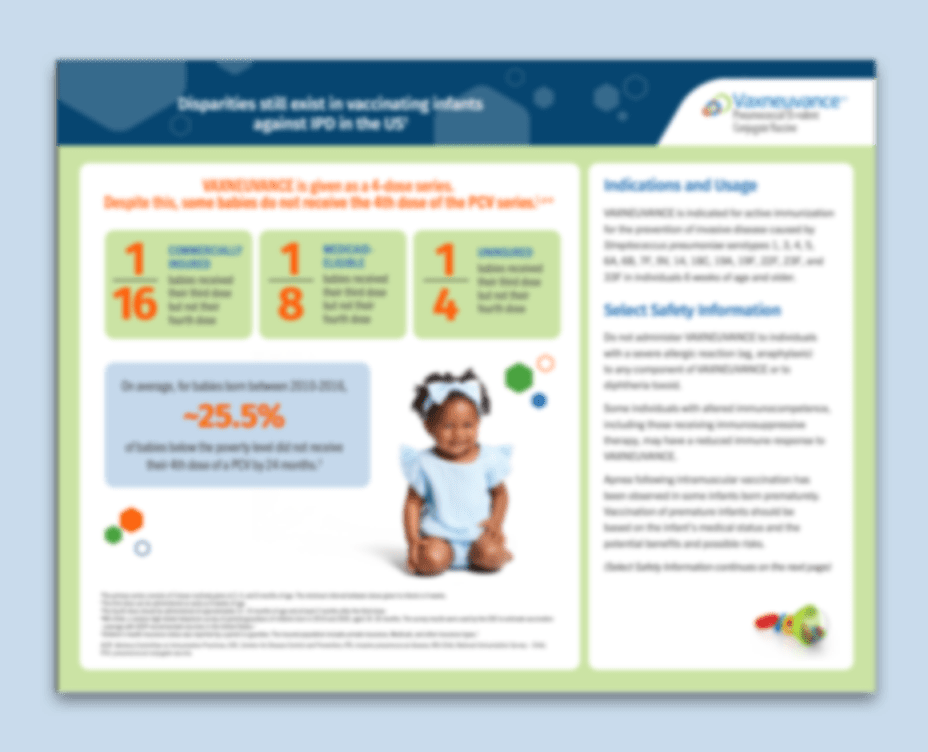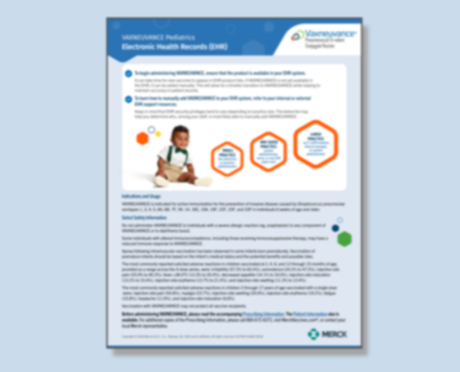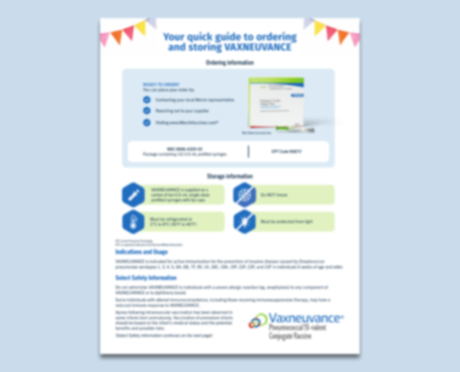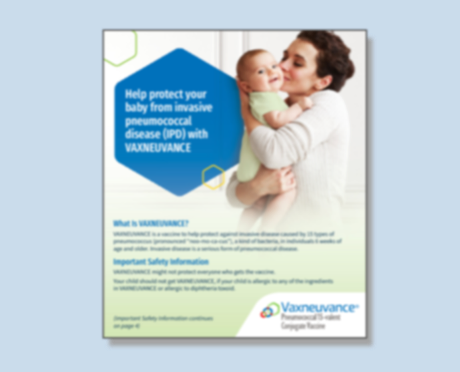
Helpful resources for VAXNEUVANCE
From a health care professional
The burden of disease and the risk of IPD in the pediatric population1-3
Family nurse practitioner Wendy L. Wright discusses the burden and risk of IPD in pediatric patients1-3
Immunogenicity matters when selecting a PCV for your pediatric population1,4-7
Family nurse practitioner Wendy L. Wright looks at why immunogenicity matters when choosing a PCV for pediatric patients1,4-7
For your practice
Help protect against invasive pneumococcal disease in children
Learn about the ongoing risk of pediatric IPD and how VAXNEUVANCE can help protect
against it.1, 8-12

Disparities in IPD vaccination coverage
Important data on incomplete vaccine series among infants


Getting started with VAXNEUVANCE
How to dose and administer, store and handle, and order VAXNEUVANCE

First year of life journey
Key details on protecting pediatric patients against IPD during this critical period
For your patients

Help protect your baby from IPD with VAXNEUVANCE
A patient-friendly overview of pediatric IPD and VAXNEUVANCE

Help protect your baby from IPD with VAXNEUVANCE (Spanish)
A patient-friendly overview of pediatric IPD and VAXNEUVANCE in Spanish
EHR, electronic health record; IPD, invasive pneumococcal disease; PCV, pneumococcal conjugate vaccine.
References
- Gierke R, Wodi P, Kobayashi M. Epidemiology and Prevention of Vaccine-Preventable Diseases (Pink Book). 14th edition. Chapter 17: Pneumococcal disease. Centers for Disease Control and Prevention. Last reviewed May 1, 2024. Accessed August 1, 2024. https://www.cdc.gov/pinkbook/hcp/table-of-contents/chapter-17-pneumococcal-disease.html?CDC_AAref_Val=https://www.cdc.gov/vaccines/pubs/pinkbook/pneumo.html
- Centers for Disease Control and Prevention (CDC). Visualization – Based on 1998-2022 serotype data for invasive pneumococcal disease cases by age group from Active Bacterial Core surveillance (ABCs). Updated July 22, 2024. Accessed September 27, 2024. https://data.cdc.gov/d/qvzb-qs6p/visualization
- Centers for Disease Control and Prevention (CDC). Active bacterial core surveillance (ABCs) report, emerging infections program network, Streptococcus pneumoniae, 2021. https://www.cdc.gov/abcs/downloads SPN_Surveillance_ Report_2021.pdf
- Weekly epidemiological record. World Health Organization. 2019;85–104. Accessed January 26, 2024. https://www.who.int/publications/i/item/10665-310968
- Recommendations to assure the quality, safety and efficacy of pneumococcal conjugate vaccines, Annex 3, TRS No 977. World Health Organization. October 19, 2013. Accessed January 26, 2024. https://www.who.int/publications/m/item/pneumococcal-conjugate-vaccines-annex3-trs-977
- Gruber MF, Marshall VB. Chapter 80: Regulation and testing of vaccines in the US. In: Orenstein WA, Offit PA, Edwards KM, Plotkin SA, eds. Plotkin’s Vaccines. 8th ed. Elsevier; 2022;1640-1659.e2.
- Guidelines on clinical evaluation of vaccines, regulatory expectations. WHO Technical Report Series 1004, Annex 9, 2017. World Health Organization. Accessed May 28, 2024. https://www.who.int/publications/m/item/WHO-TRS-1004-web-annex-9
- Wasserman M, Chapman R, Lapidot R, et al. Twenty-year public health impact of 7- and 13-valent pneumococcal conjugate vaccines in US children. Emerging Infect Dis. 2021;27(6):1627- 1636.
- Data available on request from Merck & Co., Inc., Professional Services-DAP, WP1-27, PO Box 4, West Point, PA 19486-0004. Please specify information package US-PVC-01698.
- Kaplan SL, Barson WJ, Lin Ling P, et al. Invasive Pneumococcal Disease in Children’s Hospitals: 2014- 2017. Pediatrics. 2019;144(3):e20190567.
- Centers for Disease Control and Prevention (CDC). About Pneumococcal Disease. Last reviewed February 6, 2024. Accessed July 9, 2024. https://www.cdc.gov/pneumococcal/about/?CDC_AAref_Val=https://www.cdc.gov/pneumococcal/about/infection-types.html
- Centers for Disease Control and Prevention (CDC). Pneumococcal Disease Symptoms and Complications. Last reviewed February 6, 2024. Accessed May 31, 2024. https://www.cdc.gov/pneumococcal/signs-symptoms/
